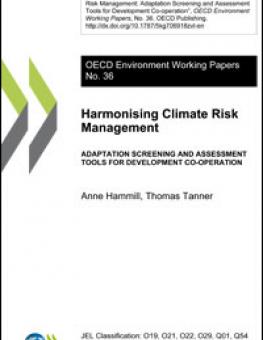
Harmonising Climate Risk Management: Adaptation screening and assessment tools for development co-operation
In this OECD Environment Working Paper, Anne Hammill and Thomas Tanner draw upon growing bodies of experience with the development and implementation of tools designed to screen for climate change risks and facilitate adaptation.
They explore the extent to which these tools are meeting user needs, and whether opportunities exist for streamlining the tools landscape. Focusing primarily on process guidance tools, the authors suggest that the increasing number and diversity of tools available makes it desirable to harmonize aspects of risk screening and assessment processes. Harmonization could be achieved through the development of: (i) common and clear terminology; (ii) a generic and common risk management framework; (iii) organization and categorization systems; and (iv) a simple, navigable clearing house for tools that allows users to identify those most relevant to their needs. Hammill and Tanner also recommend that the development community:
Continue to support training and facilitation for new users and follow-up events for existing users
Forge better links among users of process guidance tools and users of data and information provision tools in order to increase their effectiveness
Bolster support for helping users move from assessment to action through the development of common guidance or through enhanced stakeholder engagement
Work with development partners to ensure ownership and integration of risk screening and assessment tools, and thereby have a greater impact on government decision-making.
Participating experts
You might also be interested in
What’s Next After UNEA-6: Why “synergies” is more than a buzzword
In an era marked by escalating environmental challenges and geopolitical tension, the Sixth United Nations Environment Assembly (UNEA-6) called for more cooperation to tackle the triple planetary crisis.
UNFCCC Submissions Tracker
Tracking and sharing opportunities for stakeholders to give input to the UN climate change negotiations.
The State of Global Environmental Governance 2023
In global environmental talks in 2023, the focus across nearly all issue areas was funding implementation and reviewing performance.
What Is the UAE Framework for Global Climate Resilience, and How Can Countries Move It Forward?
With the introduction of the new framework for the Global Goal on Adaptation (GGA), COP 28 marked a milestone for adaptation. We unpack key outputs and set out how countries can move forward by strengthening their national monitoring, evaluation, and learning (MEL) systems.